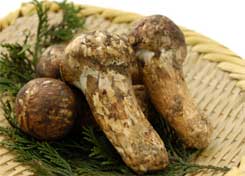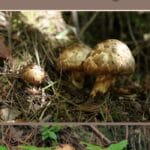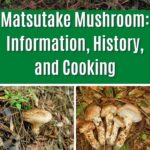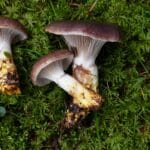No discussion about edible mushrooms would be complete without mentioning the elusive matsutake mushroom. Every year between September and January, pickers on the West Coast of North America search for this spicy-smelling mushroom with a passion usually only reserved for morel hunters.
These mushrooms are big business, with the majority harvested being exported to Japan. These edible mushrooms are prized in Japan, both for their flavor and meaning. To this day they’re still given as important gifts, meant to symbolize fertility and happiness.
Yet it’s not only the Japanese that love these pine mushrooms. Matsutake are held in high regard the world over for their powerful flavor and odor. They’re a sensory adventure often referred to as “spicy”, “intense”, or “like cinnamon”. Although some would prefer the terms “foul” or “pungent”!

These words do little justice to the true spicy intensity of the mushroom, which is better experienced than described. Few people have a moderate opinion here; they either love them or hate them.
A closer look will tell us more about these unusual specimens. We’ll start with some basic facts, and move on to their status as a famous edible mushroom. We’ll end with a discussion of some of the culture and controversy surrounding their collection.
Matsutake Mushroom Facts
- They are sometimes called “pine mushrooms” due to their association with certain types of pine trees.
- Pine mushrooms begin their lives looking pure white and smooth, they soon develop brown spots and scales.
- Their caps are usually around 2 to 8 inches across (5 to 20 cm) and convex. When the mushroom is young, the caps have a distinct curl to their edges.
 Stems are 2 to 6 inches (4 to 15 cm) tall and are firm throughout, never hollow. The stems often have an interesting two-toned look, with the area below the ring displaying their brownish discolorations, and the area above being pure white.
Stems are 2 to 6 inches (4 to 15 cm) tall and are firm throughout, never hollow. The stems often have an interesting two-toned look, with the area below the ring displaying their brownish discolorations, and the area above being pure white.- These mushrooms have a ring around the stem, which is a remnant of their partial veil. The partial veil is a layer of tissue that runs from the outer edge of the cap and connects to the stem. Its function is to protect the developing gills when the mushroom is young.
- Their spore print is white.
- Matsutake are most commonly found in North America in California and the Pacific Northwest. However, they are known to grow in other places such as Japan, Korea, China, and the Northern European countries of Sweden and Finland.
- Pine mushrooms are mycorrhizal partners with various species of trees (more on this below). They are mainly found under pine and fir trees, but sometimes under hardwoods such as oaks or tanoaks.
- They start popping up in late summer and fall (Sep-Oct) in cooler climates and winter (through Jan) in warmer climates.
- As with so many mushrooms, the Latin naming convention isn’t always so cut and dry. Asian and Northern European species are referred to as Tricholoma matsutake, while North American mushrooms are often called Tricholoma magnivelare. At this point it is unclear whether these are actually the same species.
Infamous Edible Mushrooms
When cooking with a matsutake mushroom, one should consider a rule applicable to so many things in life: less is more. Sometimes the flavor is so pungent it can overwhelm your dish. Better to start with a small amount and work your way up.
This is a meaty mushroom that works well in many different types of recipes. It can be an acquired taste, so I’d recommend trying it in a few dishes before you decide that it’s too spicy or weird.
Pine mushrooms become heavy and wet when washed with water directly. Wipe them down thoroughly with a damp cloth or paper towel before cooking, rather than soaking or putting them under running water.
A few more cooking hints:
- Store them in the refrigerator if not using right away, no more than 10 days.
- Matsutake work best in recipes without a lot of butter or cream. These heavy ingredients don’t mix well with their unique, pine-like flavor.
 These babies will easily overpower the taste of other gourmet mushrooms. So save your chanterelles, porcini, and black trumpets for their own recipe. White buttons are okay, as they will just absorb the other flavors of the dish.
These babies will easily overpower the taste of other gourmet mushrooms. So save your chanterelles, porcini, and black trumpets for their own recipe. White buttons are okay, as they will just absorb the other flavors of the dish.- Younger mushrooms are believed to be of higher quality with a more intense aroma. These are mushrooms with smaller, unopened caps and unbroken veils.
- Much like truffles, use the KISS method when creating recipes. That is: Keep It Simple, Silly! Let the smell and flavor of the mushroom be the highlight of the dish.
- For the best taste, texture, and flavor, cook them lightly and serve while they’re still firm. Don’t overcook to the point that they’re soft or mushy.
As much as I love Japanese food, I’m admittedly no expert at cooking it. That’s why I like preparing matsutake gohan, a Japanese rice dish made with pine mushrooms. It’s easy, tasty, and showcases their unique flavor.
Matsutake Mushroom Gohan
Ingredients:
- 2 large matsutake mushrooms (or 3 medium ones)
- 2 1/2 cups Japanese rice
- 2 tablespoons sake (Japanese rice wine)
- 1 tablespoon mirin (a sweet-tasting Japanese cooking wine, can be omitted if you can’t find it)
- 2 tablespoons soy sauce
- 2 cups kombu dashi (soup stock made from kelp and water, amazingly good!)
- 1/2 teaspoon salt
Clean the mushrooms with a damp cloth and cut them lengthwise into 1/8” pieces.
Add all the ingredients in a small cast-iron or stainless steel pot. Stir them well, and let them sit for 20 minutes to an hour to let the flavors start melding.
Bring the mixture to a boil by turning the heat to high. When it starts boiling, reduce the heat to medium-low. Cover the pot with a lid and let it simmer for 20 minutes.
Turn off the heat, but keep the lid on and let the dish cook for another 10 minutes or so. Then remove from heat, fluff, and wait until it cools to an edible temperature.
This recipe is really simple but really good! It’s an easy matsutake mushroom recipe that serves as a good introduction to their complex flavor.
Pine Mushroom Problems
There are some definite controversy and competition over pine mushrooms. This all stems from the fact that they’re mycorrhizal.
A mycorrhizal mushroom is one that forms a symbiotic relationship with the roots of trees or plants. This relationship benefits both parties, as the mushrooms receive sugars from the trees and the trees get access to more nutrients and water. Think of the mushroom mycelium coating the tree roots as fingers extending their reach.
The problem? This is a very complex relationship, one not fully understood by modern science. Simulating this is difficult to impossible in a lab or outside. It has to happen naturally, which means that matsutake, sadly, aren’t cultivated commercially.
When cultivation isn’t possible, we must turn to collection to get our fungal fix. Given the high demand for these mushrooms and the high price they fetch, the industry around picking them is very cutthroat.
The demand for these mushrooms has lead to a few big concerns:
- Conflict between commercial pickers and mycophiles. Many nature lovers hate to see their patches raided by those who have more of an interest in making money than in the mushrooms themselves.
- Treatment of commercial pickers. Lots of commercial pickers in the Pacific Northwest are migrant workers from Mexico and other countries. These people can work long and hard hours, and aren’t paid very much compared to what they bring in. It’s sad to hear of people being exploited.
- Environmental damage. This is a big one. Millions of pounds of matsutake are removed from the ecosystem each year, and we have no idea what this is doing to the environment.
Some say that environmental damage isn’t such a concern. I disagree!
Mycorrhizal mushrooms help keep a forest healthy, and trees strong. If you weaken one link, others are sure to break down as well. Trees may die. Animals can suffer. The food chain is affected as nature’s balance is plunged into a downward spiral.

We don’t know the long-term impact of removing so many mushrooms from wild areas, especially younger ones that may not have dropped spores yet. Given how everything is connected, I find it hard to believe that this wouldn’t eventually be damaging to a forest.
Thus it’s important to respect matsutake as you would any mushroom. Don’t pick more than you need. If picking commercially, leave some in every patch so they can drop their spores and propagate.
If you want to learn more about matsutake mushroom identification and picking, I’d recommend checking out the Matsiman website. This site has tons of great information presented from a respectful standpoint.
Hopefully this article has piqued your interest in matsutake mushroom. The next time an adventurous culinary spirit hits you, give them a try!









johnson kottaram
Hi there; your blog here is very informative and helped me understand more about the world of mushrooms and our interconnectedness.
Your blog has prompted me to buy the book:
The Mushroom at the End of the World
On the Possibility of Life in Capitalist Ruins
By: Anna Lowenhaupt Tsing
Thank you
Johnson
Jenny
Ah, that’s a good book! You can also find it as an audiobook; I listened to it on a long car drive. Fascinating!